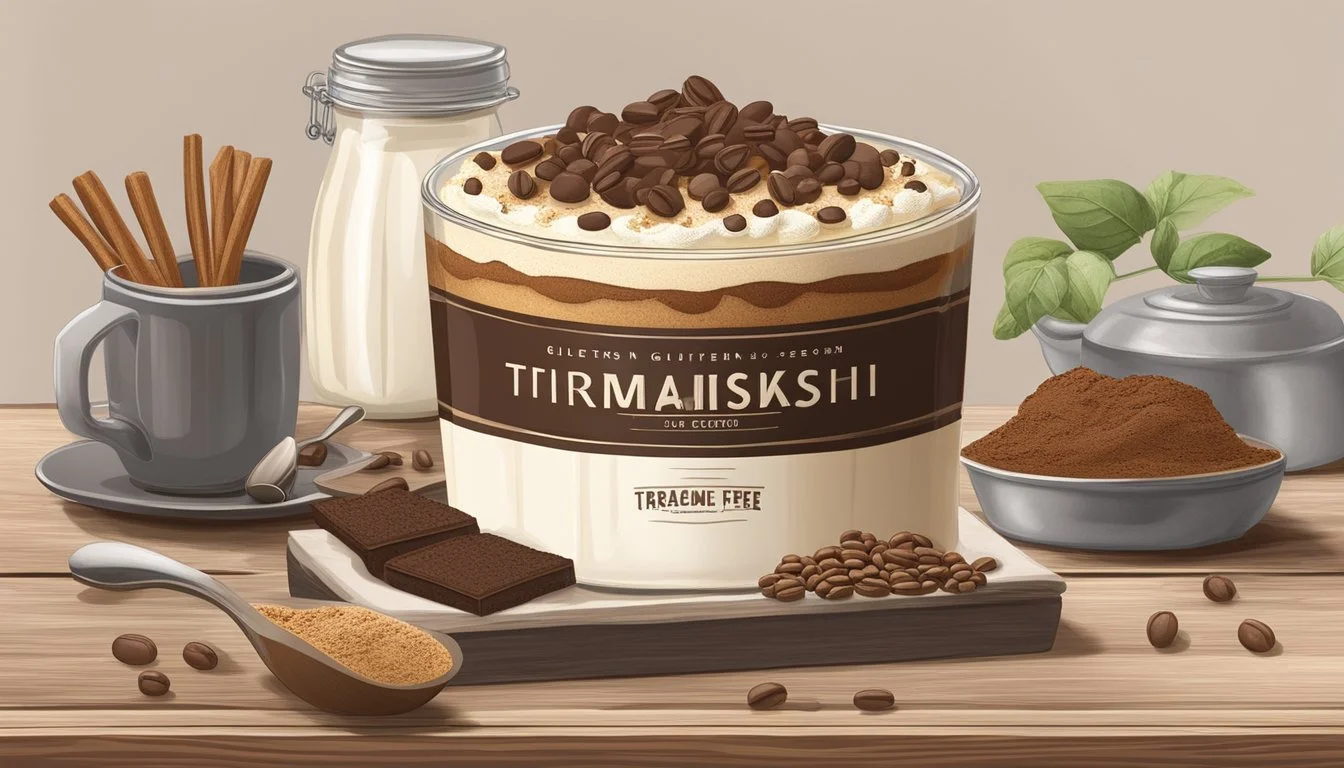Is Tiramisu Gluten-Free?
Understanding the Ingredients and Preparation
Tiramisu, a classic Italian dessert, is celebrated for its rich layers of coffee-soaked ladyfingers, sweet mascarpone cheese, and a dusting of cocoa powder. Traditionally, the dessert includes wheat-based ladyfingers, making it unsuitable for those with gluten sensitivities or celiac disease. However, with the increasing availability of gluten-free alternatives, tiramisu can be adapted to suit a gluten-free diet without compromising on its iconic taste and texture.
Gluten-free tiramisu relies on using gluten-free ladyfingers or alternative cake layers that mimic the light, airy texture of the original biscuit. These gluten-free components are soaked in coffee, just as in the traditional recipe, ensuring the dessert retains its signature flavor. The mascarpone custard layer, inherently gluten-free, remains unchanged, providing the creamy contrast to the coffee-infused base.
While gluten-free adaptations of tiramisu are now more accessible, careful attention must be paid to ensure all ingredients, including any flavorings or additives, are free from gluten. Some recipes may also include alcohol such as rum or Marsala wine, so it's essential to verify that these are safe for those following a gluten-free regimen. The result is a delightful dessert that can be enjoyed by a broader audience, allowing everyone to savor the indulgence of tiramisu.
What Is Tiramisu?
Tiramisu is a classic Italian dessert known for its distinctive layers and rich flavor profile. This section delves into the historical roots of this beloved treat and the essential components that make up its unique taste.
Historical Background
Tiramisu, meaning "pick me up" or "cheer me up" in Italian, is a dessert that originated in Italy during the 20th century. Despite numerous tales about its creation, the most accepted narrative situates its birth in the Veneto region of Italy. Tiramisu is celebrated for its indulgent layering of ingredients and is often associated with Italian cuisine's artistry and tradition.
Key Ingredients
The quintessential Tiramisu is composed of several key ingredients, each contributing to its iconic flavor and texture:
Mascarpone Cheese: A creamy Italian cheese, mascarpone is the foundation of Tiramisu's rich custard-like layer.
Ladyfingers: Known as Savoiardi in Italian, these light and airy sponge biscuits are briefly soaked in coffee to add moisture without becoming soggy.
Egg Yolks: Combined with sugar, egg yolks are whisked to create a thick base for the mascarpone mixture.
Coffee: Typically, a strong espresso is used to imbue the ladyfingers with a robust coffee flavor.
Cocoa Powder: A dusting of fine cocoa powder provides a bittersweet finish to the dessert.
Liqueur: While optional, spirits such as rum or Marsala wine can be added to the coffee for an extra depth of flavor.
These components are systematically layered to create the traditional dessert, with coffee-dipped ladyfingers forming the base and a generous spread of the mascarpone mixture on top. A sifting of cocoa powder often completes the dish, offering an attractive finish and a hint of chocolate to balance the flavors.
Unveiling The Gluten-Free Aspect
When considering a gluten-free diet, either due to celiac disease or personal preference, understanding the components of traditional desserts (What wine goes well with desserts?) and their gluten-free alternatives is crucial. This section explores what gluten is and how certain ingredients can be substituted in tiramisu to cater to a gluten-free lifestyle.
Understanding Gluten
Gluten is a group of proteins commonly found in wheat, barley, and rye. It acts as a binding agent, giving elasticity and a chewy texture to breads and baked goods. For individuals with celiac disease, gluten triggers an immune response that damages the lining of the small intestine, leading to malabsorption and other health issues. Hence, maintaining a strict gluten-free diet is essential for their well-being.
Gluten-Free Ingredients
A classic tiramisu typically includes ladyfingers, a sponge cake that contains gluten. However, for a gluten-free tiramisu, the traditional wheat-based ladyfingers are replaced with a gluten-free sponge cake or gluten-free ladyfingers made from alternative flours such as almond flour or tapioca starch. These flours do not contain gluten and are safe for those with celiac disease.
Gluten-Free Ladyfingers can be made using the following recipe:
Almond Flour: A nut-based flour known for its rich flavor and health benefits.
Tapioca Starch: It provides the chewiness that mimics gluten's properties.
Baking Powder: Ensures the ladyfingers rise properly.
When creating gluten-free tiramisu from scratch, one must verify all other ingredients are gluten-free as well, such as the mascarpone cheese and cocoa powder used for dusting. The market also offers ready-made gluten-free ladyfingers to simplify the process. Always read labels to ensure there is no cross-contamination or hidden sources of gluten.
By using these substitutes, it is possible to recreate the beloved tiramisu without compromising on taste or texture, ensuring that those on a gluten-free diet can still indulge in this exquisite Italian dessert.
Preparing Gluten-Free Tiramisu
Creating a gluten-free tiramisu requires attention to ingredients and alternatives to ensure the classic flavor and texture are maintained without gluten content. This section discusses how to make gluten-free tiramisu, featuring a recipe and suggestions for substitutions that accommodate various dietary restrictions.
Gluten-Free Tiramisu Recipe
Ingredients:
Homemade Gluten-Free Ladyfingers:
Eggs
Granulated sugar
Mascarpone Cream:
Mascarpone cheese
Heavy cream
Sugar
Vanilla extract
Espresso Dipping Mixture:
Espresso coffee
Coffee liqueur (optional)
Instructions:
Ladyfingers:
Separate egg whites and yolks.
Beat egg whites until stiff peaks form. In another bowl, whisk yolks with sugar until pale.
Fold in gluten-free flour to the yolk mixture, then incorporate the egg whites gently to keep the air in the batter.
Pipe or spread batter into strips and bake until crisp.
Mascarpone Cream:
Combine mascarpone cheese, heavy cream, sugar, and vanilla extract.
Whisk until the mixture reaches a smooth and creamy consistency.
Assembly:
Quickly dip each homemade ladyfinger into the espresso mixture.
Lay the dipped ladyfingers in a dish to create a single layer.
Spread half of the mascarpone cream over the ladyfingers.
Repeat layers and finish with a layer of mascarpone cream.
Dust with cocoa powder and refrigerate for several hours to set.
Alternative Ingredients and Substitutions
Gluten-Free Tiramisu also offers flexibility in terms of ingredients, catering to those who require dairy-free or alcohol-free variants:
Dairy-Free Options:
Replace mascarpone with dairy-free cream cheese mixed with dairy-free whipped cream.
Opt for dairy-free heavy cream alternatives to whip into the cream mixture.
Alcohol-Free Variant:
Omit coffee liqueur from the espresso dipping mixture.
Use either more espresso or a combination of espresso and chocolate syrup or vanilla for flavor depth.
Remember, maintaining the balance of flavors is key when substituting. Experiment with quantities to achieve the desired taste and consistency.
Safety Considerations in Tiramisu Preparation
Tiramisu often calls for the use of eggs in its preparation, which raises concerns about food safety. Specifically, the traditional recipe requires raw or uncooked eggs that may pose a risk of food-borne illness. Two key safety considerations in the preparation of tiramisu involve the use of pasteurized eggs to mitigate risks and the exploration of alternatives to uncooked eggs.
Pasteurized Eggs
When preparing tiramisu, it's imperative to consider the use of pasteurized eggs. Pasteurized eggs have been heat-treated to destroy harmful bacteria such as Salmonella without cooking the egg itself. This process ensures the safety of consuming the eggs in a raw or lightly cooked state, which is common in tiramisu recipes. To verify the use of pasteurized eggs:
Look for labels: Packaging should explicitly state that the eggs are pasteurized.
Consider reputable sources: Purchase eggs from trusted suppliers who follow stringent safety protocols.
Using pasteurized eggs is especially crucial if the tiramisu is being served to the elderly, young children, pregnant women, or those with compromised immune systems.
Raw Eggs Alternatives
For those who prefer to avoid raw eggs entirely, there are alternatives to using raw eggs in tiramisu. Some options maintain the creamy texture essential to the dessert while removing the risks associated with uncooked eggs:
Egg substitutes: Commercial egg substitutes often come pasteurized and are a safe alternative to raw eggs.
Whipped cream: Heavy whipping cream can be used to achieve a similar consistency and is safe to consume without cooking.
Mascarpone cream only: Mascarpone, the cheese used in tiramisu, can be whipped and used to create layers without the addition of eggs.
It's important to ensure that any alternative maintains the integrity of the tiramisu flavor and texture while adhering to food safety standards.
Serving and Presentation of Tiramisu
When presenting Tiramisu, its visual appeal is just as important as its taste. The serving of this dessert can range from elegant individual portions to a more communal, shareable dish, with garnishing playing a key role in its allure.
Garnishing and Decoration
For a touch of sophistication and added flavor, tiramisu is often dusted with a fine layer of cocoa powder right before serving. This not only enhances the taste but also provides a visually appealing contrast to the creaminess of the mascarpone layer. Additionally, chocolate shavings or curls made from dark chocolate can be sprinkled on top for both texture and appearance. If desired, a light sprinkle of powdered sugar can add a hint of sweetness and a snow-like effect.
Serving Suggestions
Tiramisu can be assembled in various ways: either baked or as a no-bake dessert. For serving, it should be sufficiently chilled to allow the layers to set—typically for at least 3-4 hours or, ideally, overnight. It is traditionally plated by slicing or scooping out portions from a larger dish. When serving, it is crucial to consider the presentation; a clean cut will expose the intricate layers of soaked ladyfingers and rich mascarpone cream, making the dessert as enticing to the eye as it is to the palate. Individual servings can also be prepared in cups or glasses, showcasing the layers vertically.
Tiramisu Variations and Related Desserts
Traditional tiramisu is not gluten-free, but numerous variations cater to gluten-free and other special diet requirements. This section delves into dairy-free adaptations and desserts that are inspired by the classic tiramisu, each maintaining the essence of the original while providing an alternative for those with dietary restrictions or preferences.
Dairy-Free and Other Special Diets
Tiramisu can be adapted for various dietary needs without sacrificing its indulgent nature. Dairy-free tiramisu substitutes the classic mascarpone with non-dairy alternatives such as coconut cream or almond-based mascarpone which mimic the texture and richness of the original dairy ingredient.
Grain-Free: A common approach is to replace traditional ladyfingers with almond flour-based sponge or other grain-free options, providing a lighter, more dietary-friendly dessert.
Dairy-Free Alternatives: For the mascarpone filling:
Coconut Cream
Almond Mascarpone
Silk Tofu (blended with non-dairy milk and sweetener to taste)
Adhering to special diets doesn't mean missing out on delectable desserts. Chefs use creativity to transform classic recipes into cheesecake versions that might blend ricotta or cream cheese to achieve a similar creamy consistency, or into cupcakes that incorporate the distinct flavors of tiramisu in a gluten-free or dairy-free cupcake form.
Desserts Inspired by Tiramisu
Tiramisu has inspired a variety of desserts, infusing its signature flavors into novel sweet creations.
Tres Leches Cake: A dessert that can be flavored with espresso and layered with mascarpone frosting to evoke the tiramisu experience in a different form.
Irish Cream Tiramisu: An innovative take that integrates Irish cream into the recipe for an added kick, often enjoyed by adults for its unique flavor blend.
Following the tiramisu theme, some bakers have created a fusion of tiramisu and other popular desserts:
Cupcakes: Infused with coffee and layered with a mascarpone topping, these handheld treats deliver the tiramisu taste in a single-serving size.
Cheesecake: Incorporating coffee and mascarpone layers, this variation presents a sliceable version of tiramisu that satisfies cheesecake lovers.
Through these variations and related desserts, tiramisu's essence is preserved and celebrated, even as it is reinvented for different dietary needs and dessert formats.
Complementary Beverages with Tiramisu
Selecting the perfect drink to accompany tiramisu enhances the flavors and can create a more sophisticated dessert experience. Both non-alcoholic and alcoholic options can complement the dessert's creamy and coffee-based notes.
Coffee and Tea Pairings
Tiramisu naturally pairs well with coffee, as its components are designed to echo this robust flavor. An espresso provides a strong, concentrated coffee essence that echoes the intensity of the dessert. For those preferring a non-caffeinated option, decaffeinated coffee is suitable and maintains the coffee flavor profile without the stimulating effects. Tea lovers might opt for a black or chai tea, which provides a warm spice complement to the mascarpone and coffee layers in tiramisu.
Ideal Coffee Pairings
Espresso: Intensifies tiramisu's coffee notes.
Decaffeinated Coffee: Offers the coffee taste without caffeine.
Tea Options
Black Tea: Its boldness balances the sweetness of tiramisu.
Chai Tea: Adds a spiced dimension to the creamy dessert.
Liqueurs and Alcohol Pairings
A variety of liqueurs and spirits can elevate tiramisu's flavor profile. For instance, marsala wine, a traditional tiramisu ingredient, makes for an excellent pairing. Still, one may opt for alternatives like a smooth rum or an amaretto, which introduces a subtle almond note that complements the creamy layers. A coffee liqueur could intensify the main coffee flavor of the dessert while adding a touch of sweetness.
Alcohol and Liqueur Pairings
Marsala Wine: Traditional choice that enhances depth.
Rum: Adds warmth and complexity.
Amaretto: Pairs its nutty flavor with the sweet layers.
Coffee Liqueur: Reinforces the coffee-centric theme.
Tiramisu FAQs and Troubleshooting
Tiramisu, an Italian dessert, can be modified to be gluten-free and involves steps where precise technique is key. This section addresses common questions and how to navigate potential preparation challenges.
Common Questions
Is traditional Tiramisu gluten-free? No, traditional tiramisu includes Savoiardi or ladyfingers that contain wheat flour. For a gluten-free version, it's crucial to use gluten-free ladyfingers or an alternative such as sponge cake made with gluten-free flour.
Can the creamy filling be made in advance? Yes, the creamy filling which typically consists of mascarpone cheese mixed with whipped cream and, in some recipes, beaten egg whites, can be prepared in advance. It's important to achieve stiff peaks when whipping cream or egg whites to ensure the filling maintains its structure.
Solving Preparation Issues
Whipped Cream Isn't Forming Stiff Peaks: Make sure that the cream is very cold before whipping. If peaks are not forming, a common solution is to place the bowl and whisk into a freezer for a few minutes before reattempting. Also, ensure that the cream has a high enough fat content; a minimum of 30% fat is recommended for whipping.
Egg Whites Won't Whip to Stiff Peaks: Egg whites should be at room temperature to whip properly. Any traces of yolk or fat can hinder this process, so separate the whites carefully. A clean, dry bowl is also essential. For additional stability, it's sometimes helpful to add a pinch of cream of tartar before beating.
Creamy Filling is Too Runny: The filling may become too runny if the mascarpone cheese is overmixed or if it's combined with whipped cream that has not reached stiff peaks. To solve this, one should gently fold the whipped cream into the mascarpone mixture to preserve the airiness and structure.
Water Bath Considerations: If a recipe calls for a water bath (known as a bain-marie), its purpose is to moderate the temperature. It's important to use hot water but avoid overfilling, as the steam should not come into contact with the tiramisu. The dessert should not be submerged in water at any point; it's the gentle heat that aids the cooking process.
Where to Find Gluten-Free Tiramisu Ingredients
Finding gluten-free tiramisu ingredients can be a simple task when knowing where to look. Shoppers have access to a variety of platforms from online retailers to specialty stores, providing all the necessary components for a delicious gluten-free dessert.
Online Retailers
Amazon stands out as a major online retailer where customers can easily search for and purchase gluten-free tiramisu ingredients. Products like Schar's Gluten-Free Ladyfingers are readily available, often with the convenience of customer reviews and the option to buy in bulk. Shoppers can benefit from features such as:
Quick comparison of prices
Reading customer reviews for product quality assurance
Utilize Amazon Associate links found on sites like Facebook or Pinterest for recommended products
Specialty Stores
Specialty stores, often local or regional, are ideal for those seeking high-quality, certified gluten-free ingredients. They typically provide a curated selection such as freshly made gluten-free sponge cake or Savoiardi biscuits, which are essential for authentic tiramisu. At these stores, shoppers may find:
Staff with detailed knowledge of gluten-free products
Locally produced ingredients ensuring freshness
Items not commonly found in generic supermarkets
Each shopping option has its own advantages, whether it is the convenience of browsing online or the in-person expertise and product variety found at specialty stores.
Engaging the Tiramisu Community
The Tiramisu community thrives on the collective enthusiasm for sharing and discussing gluten-free variations of this classic Italian dessert. Whether it’s across social media platforms or within designated discussion forums, members benefit from a wealth of shared knowledge and experiences.
Sharing Recipes on Social Media
Social media platforms offer a bustling environment for tiramisu enthusiasts to share gluten-free recipes and presentation tips. On Facebook, users can post photos and step-by-step guides of their tiramisu creations in dedicated groups, often resulting in lively discussions and valuable feedback. Pinterest serves as a visual catalog, where individuals can discover and save a vast array of tiramisu recipes, categorized by their ingredients and complexity. Here's a simple snapshot:
Facebook: Active groups for real-time recipe sharing and feedback.
Pinterest: A repository for inspiration and recipe curation.
Joining Discussion Forums
For a more focused exchange of ideas, tiramisu aficionados may turn to discussion forums. These forums are digital meeting grounds where the specifics of making gluten-free tiramisu, such as alternative ingredients or preparation techniques, are dissected and debated. Members of the community keen on perfecting their dessert often consider forums an invaluable resource for obtaining detailed advice as well as moral support from fellow gluten-free practitioners.









